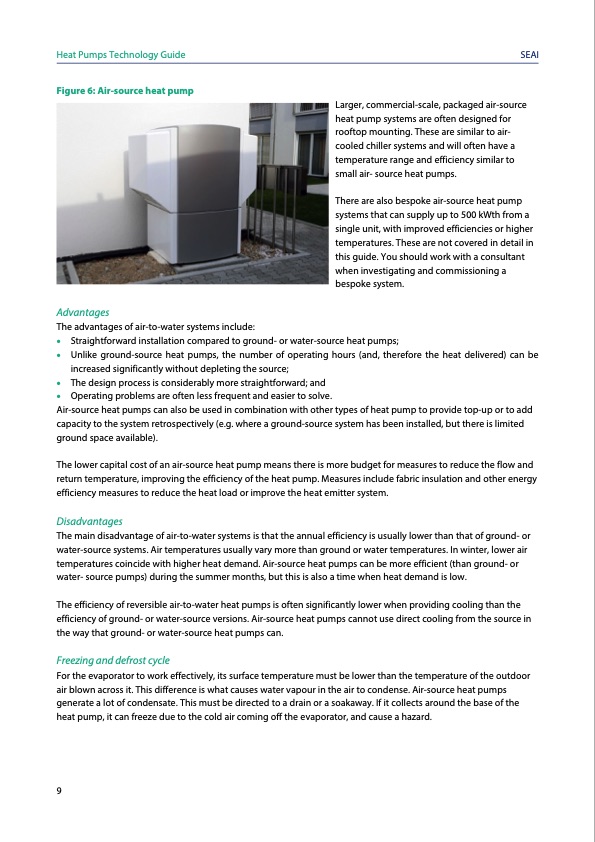
PDF Publication Title:
Text from PDF Page: 013
Heat Pumps Technology Guide SEAI Figure 6: Air-source heat pump Larger, commercial-scale, packaged air-source heat pump systems are often designed for rooftop mounting. These are similar to air- cooled chiller systems and will often have a temperature range and efficiency similar to small air- source heat pumps. There are also bespoke air-source heat pump systems that can supply up to 500 kWth from a single unit, with improved efficiencies or higher temperatures. These are not covered in detail in this guide. You should work with a consultant when investigating and commissioning a bespoke system. Advantages The advantages of air-to-water systems include: • Straightforward installation compared to ground- or water-source heat pumps; • Unlike ground-source heat pumps, the number of operating hours (and, therefore the heat delivered) can be increased significantly without depleting the source; • The design process is considerably more straightforward; and • Operating problems are often less frequent and easier to solve. Air-source heat pumps can also be used in combination with other types of heat pump to provide top-up or to add capacity to the system retrospectively (e.g. where a ground-source system has been installed, but there is limited ground space available). The lower capital cost of an air-source heat pump means there is more budget for measures to reduce the flow and return temperature, improving the efficiency of the heat pump. Measures include fabric insulation and other energy efficiency measures to reduce the heat load or improve the heat emitter system. Disadvantages The main disadvantage of air-to-water systems is that the annual efficiency is usually lower than that of ground- or water-source systems. Air temperatures usually vary more than ground or water temperatures. In winter, lower air temperatures coincide with higher heat demand. Air-source heat pumps can be more efficient (than ground- or water- source pumps) during the summer months, but this is also a time when heat demand is low. The efficiency of reversible air-to-water heat pumps is often significantly lower when providing cooling than the efficiency of ground- or water-source versions. Air-source heat pumps cannot use direct cooling from the source in the way that ground- or water-source heat pumps can. Freezing and defrost cycle For the evaporator to work effectively, its surface temperature must be lower than the temperature of the outdoor air blown across it. This difference is what causes water vapour in the air to condense. Air-source heat pumps generate a lot of condensate. This must be directed to a drain or a soakaway. If it collects around the base of the heat pump, it can freeze due to the cold air coming off the evaporator, and cause a hazard. 9PDF Image | Heat Pumps Technology Guide

PDF Search Title:
Heat Pumps Technology GuideOriginal File Name Searched:
Heat-Pump-Technology-Guide.pdfDIY PDF Search: Google It | Yahoo | Bing
CO2 Organic Rankine Cycle Experimenter Platform The supercritical CO2 phase change system is both a heat pump and organic rankine cycle which can be used for those purposes and as a supercritical extractor for advanced subcritical and supercritical extraction technology. Uses include producing nanoparticles, precious metal CO2 extraction, lithium battery recycling, and other applications... More Info
Heat Pumps CO2 ORC Heat Pump System Platform More Info
| CONTACT TEL: 608-238-6001 Email: greg@infinityturbine.com | RSS | AMP |